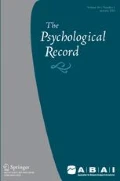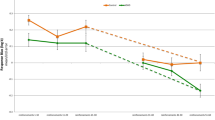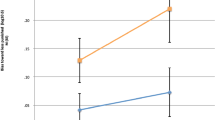Abstract
The behavior of children diagnosed with Attention-Deficit Hyperactivity Disorder (ADHD) has been hypothesized to involve differential sensitivity to parameters of reward and punishment. However, support for these theories has been limited because, in part, of the methods used to investigate them. The current study examined the behavior of six ADHD children and six comparison children on a computer task designed to present different parameters of reinforcement by using concurrent reinforcement schedules. A quantitative analysis of the sensitivity to changing contingencies of reinforcement was conducted by examining the performance of the children across five experimental conditions. Results suggest that although there may have been several mediating variables, children diagnosed with ADHD may show less sensitivity to changing parameters of reinforcement rate as measured by response ratios and time allocation to two concurrently available alternatives. Implications of these results are discussed in terms of the utility of such experimental methods in the study of childhood behavior disorders.
Similar content being viewed by others
References
ACHENBACH, T. M. (1991). Manual for the Child Behavior Checklist/4–18 and 1991 Profile. Burlington, VT: University of Vermont Department of Psychiatry.
AMERICAN PSYCHIATRIC ASSOCIATION. (1987). Diagnostic and statistical manual of mental disorders (3rd ed., rev.). Washington, DC: Author.
AMERICAN PSYCHIATRIC ASSOCIATION. (1994). Diagnostic and statistical manual of mental disorders(4th ed.). Washington, DC: Author.
BARBER, M. A., & MILICH, R. (1989). The effects of reinforcement schedule and task characteristics on the behavior of attention deficit-hyperactivity disordered boys. Poster presented at the first annual meeting for the Society for Research in Child and Adolescent Psychopathology, Miami, FL.
BARKLEY, R. A. (1988). Attention. In M. G. Tramontana & S. R. Hooper (Eds.), Assessment issues in child neuropsychology(pp. 145–176). New York: Plenum.
BARKLEY, R. A. (1989). The problem of stimulus control and rule-governed behavior in Attention Deficit Disorder with Hyperactivity. In L. M. Bloomingdale & J. Swanson (Eds.), Attention deficit disorder: Current concepts and emerging trends in attentional and behavioral disorders of childhood (pp. 203–234). New York: Pergamon.
BARKLEY, R. A. (1991). Attention deficit hyperactivity disorder: A handbook for diagnosis and treatment. New York: Guilford Press.
BAUM, W. M. (1974). On two types of deviation from the matching law: Bias and undermatching. Journal of the Experimental Analysis of Behavior, 22, 231–242.
BAUM, W. M. (1979). Matching, undermatching, and overmatching in studies of choice. Journal of the Experimental Analysis of Behavior, 32, 269–281.
CUNNINGHAM, S. J., & KNIGHTS, R. M. (1978). The performance of hyperactive and normal boys under differing reward and punishment schedules. Journal of Pediatric Psychology, 3, 195–201.
DAVISON, M., & MCCARTHY, D. (1988). The matching law. Hillsdale, NJ: Lawrence Erlbaum Associates.
DOUGLAS, V. I., & PARRY, P. A. (1983). Effects of reward on delayed reaction time task performance of hyperactive children. Journal of Abnormal Child Psychology, 11, 313–326.
DUPAUL, G. J. (1990). The ADHD Rating Scale: Normative data, reliability, and validity. Unpublished manuscript. University of Massachussetts Medical Center, Worcester.
FIRESTONE, P., & DOUGLAS, V. (1975). The effects of reward and punishment on reaction times and autonomic activity in hyperactive and normal children. Journal of Abnormal Child Psychology, 3, 201–216.
GORDON, M. (1979). The assessment of impulsivity and mediating behaviors in hyperactive and nonhyperactive boys. Journal of Abnormal Child Psychology, 7, 317–326.
HAENLEIN, M., & CAUL, W. F. (1987). Attention deficit disorder with hyperactivity: A specific hypothesis of reward dysfunction. Journal of the American Academy of Child and Adolescent Psychiatry, 26, 356–362.
HERRNSTEIN, R. J. (1970). On the law of effect. Journal of the Experimental Analysis of Behavior, 13, 243–266.
HORNE, P. J., & LOWE, C. F (1993). Determinants of human performance on concurrent schedules. Journal of the Experimental Analysis of Behavior, 59, 29–60.
JOHNSTON, J. M., & PENNYPACKER, H. S. (1993). Strategies and tactics of behavioral research. Hillsdale, NJ: Lawrence Erlbaum Associates.
KOLLINS, S. H. (1995). Human matching in the laboratory: A second look at concurrent variable-interval schedules. Bulletin of the Experimental Analysis of Human Behavior Special Interest Group, 13, 2.
LAHEY, B. B., SCHAUGHENCY, E., HYND, G., CARLSON, C, & NIEVES, N. (1987). Attention deficit disorder with and without hyperactivity: Comparison of behavioral characteristics of clinic-referred children. Journal of the American Academy of Child Psychiatry, 26, 718–723.
MARTENS, B. K., & HOUK, J. L. (1989). The application of Hernnstein’s law of effect to disruptive and on-task behavior of a retarded adolescent girl. Journal of the Experimental Analysis of Behavior, 51, 17–27.
MCBURNETT, K., LAHEY, B. B., FRICK, P. F., RISCH, S. C, LOEBER, R., HART, E. L, CHRIST, M. A. G., & HANSON, K. S. (1991). Anxiety, inhibition, and conduct disorder in children: II. Relation to salivary Cortisol. Journal of the American Academy of Child and Adolescent Psychiatry, 30,192–196.
MCCLURE, F. D., & GORDON, M. (1984). Performance of disturbed hyperactive and nonhyperactive children on an objective measure of hyperactivity. Journal of Abnormal Child Psychology, 12, 561–571.
MCDOWELL, J. J. (1988). Matching theory in natural human environments. The Behavior Analyst, 11, 95–109.
PARRY, P. A., & DOUGLAS, V. I. (1983). Effects of reinforcement on concept identification in hyperactive children. Journal of Abnormal Child Psychology, 11, 327–340.
PELHAM, W. E., MILICH, R., & WALKER, J. L. (1986). Effects of continuous and partial reinforcement and methylphenidate on learning in children with attention deficit disorder. Journal of Abnormal Psychology, 95, 319–325.
PIERCE, W. D., & EPLING, W. F. (1983). Choice, matching, and human behavior: A review of the literature. The Behavior Analyst, 6, 57–76.
QUAY, H. C. (1987). The behavioral reward and inhibition systems in childhood behavior disorders. Unpublished manuscript.
RAPPORT, M. D., TUCKER, S. B., DUPAUL, G. J., MERLO, M., & STONER, G. (1986). Hyperactivity and frustration: The influence of control over and size of rewards in delaying gratification. Journal of Abnormal Child Psychology, 14, 191–204.
ROSENBAUM, M., & BAKER, E. (1984). Self-control behavior in hyperactive and nonhyperactive children. Journal of Abnormal Child Psychology, 12, 303–318.
SOLANTO, M. V. (1990). The effects of reinforcement and response-cost on a delayed response task in children with attention deficit disorder: A research note. Journal of Child Psychology and Psychiatry and Allied Disciplines, 31, 803–808.
SONUGA-BARKE, E. J., & LEA, S. E. (1989). Childrens’ choice: Sensitivity to changes in reinforcer density. Journal of the Experimental Analysis of Behavior, 51, 185–197.
SONUGA-BARKE, E. J., LEA, S. E., & WEBLEY, P. (1989). The development of adaptive choice in a self-control paradigm. Journal of the Experimental Analysis of Behavior, 51, 77–85.
SONUGA-BARKE, E. J., TAYLOR, E., SEMBI, S., & SMITH, J. (1992). Hyperactivity and delay aversion-l. The effect of delay on choice. Journal of Child Psychology and Psychiatry and Allied Disciplines, 33, 387–398.
WORLAND, J. (1976). Effects of positive and negative feedback on behavior control in hyperactive and normal boys. Journal of Abnormal Child Psychology, 4, 315–326.
Author information
Authors and Affiliations
Additional information
This study was submitted by the first author to the Graduate Faculty of Auburn University in partial fulfillment of the requirements for the degree of Master of Science. This study was supported in part by a grant from the Auburn University Department of Psychology for Graduate Research and portions of the study were presented at the annual meeting of the Southeastern Association for Behavior Analysis October, 1994, Savannah, GA. The authors wish to thank T. S. Critchfield; J. F. McCoy; and M. C. Newland for their helpful comments on earlier versions of this manuscript.
Rights and permissions
About this article
Cite this article
Kollins, S.H., Lane, S.D. & Shapiro, S.K. Experimental analysis of childhood psychopathology: A laboratory matching analysis of the behavior of children diagnosed with Attention-Deficit Hyperactivity Disorder (ADHD). Psychol Rec 47, 25–44 (1997). https://doi.org/10.1007/BF03395211
Published:
Issue Date:
DOI: https://doi.org/10.1007/BF03395211




